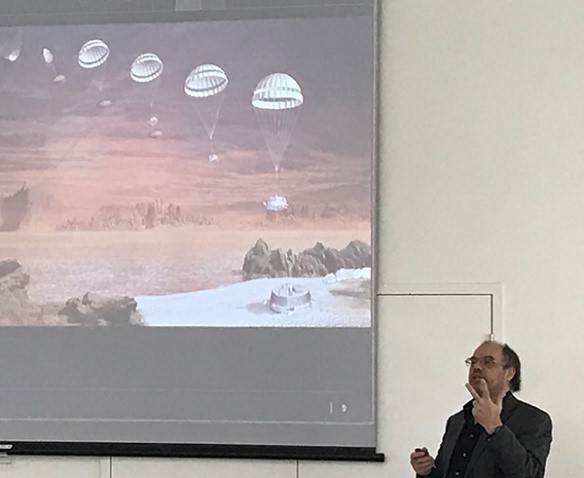November 10, 2022
Oak Ridge Partners Get a Powerful Preview from Dragonfly Mission Architect
Johns Hopkins Applied Physics Laboratory (APL) planetary scientist and aerospace engineer Ralph Lorenz recently visited Oak Ridge National Laboratory to offer the ORNL team a preview of what the Dragonfly rotorcraft might find out about possible life on Saturn’s moon Titan - and what it could tell us about life on Earth.
Around 100 employees came in person or virtually to the hourlong presentation by Lorenz, who is mission architect and geophysics/meteorology lead for Dragonfly, scheduled to launch in 2027.

Dragonfly mission architect Ralph Lorenz describes methods of exploring Saturn’s moon Titan. (Credit: ORNL)
Lorenz has past experience with Saturn’s largest moon; he worked on the Cassini mission to Titan, which resulted in radar observations of the atmosphere and landscape, and its battery-powered Huygens probe, for which he built instruments. He has decades of experience in developing concepts for the moon’s exploration, including the Titan Mare Explorer (TiME), the Titan Airship Explorer, and a submarine that would navigate the methane oceans on Titan’s surface.
He’s been part of several other NASA, European Space Agency and Japanese space missions as well, including the Mars 2020 Perseverance rover.
"There’s a lot of work ahead of us to get all the details straightened out, but this type of exploration is revolutionary," Lorenz said. "There’s not been a mission like this before. There are elements of it that are familiar in that a lot of the operations are a bit like a rover - it’s just a rover that flies."
And, given Titan’s environment and distance from Earth, he added, "it’s completely impossible to do a mission like this without radioisotope power - so we’re very appreciative of all the work you’re doing here" at ORNL.
Like the Mars rovers Perseverance and Curiosity, Dragonfly will use a multi-mission thermoelectric radioisotope generator as a power source. ORNL has a contract with NASA to produce plutonium-238 to power these devices on deep space missions.
Lorenz covered what’s known about Titan from previous missions: its environment, which includes seas of methane and large sand dunes, similar to those on earth, and its atmosphere, the density of which made a dronelike rotorcraft, with blades similar to those used on wind turbines, a good choice. (Lorenz has advocated for a rotorcraft Titan mission for about two decades, noting that Titan’s atmosphere is four times denser than Earth’s, and a rotorcraft would need 38 times less power to hover above the surface.)
But it’s the potential biology on Titan, previously unreachable, that’s most exciting, he said.
"Why Titan is so astrologically interesting is that it is just awash with organic molecules," Lorenz said. "All the molecules that execute the functions of life that perform metabolism to release free energy, that perform the functions of information storage and replication - that’s the bit that we don’t understand. And all the chemical evidence of how we got from simple molecules to you or I, all that story on Earth has been obliterated by 4.5 billion years of tectonic movements, right? If there are molecules sitting around, something’s going to eat them.
"So we don’t know how these steps happen, but we can go to Titan where we think some of these steps took place and are frozen, and look at the chemical species that can evolve from the simplest building blocks."
Lorenz hopes Dragonfly will get samples from Titan that show amino acids and pyrimidines, where water from Titan’s warmer interior might have come into contact with the organic matter that make up Titan’s sand dunes. To maximize these chances, the craft’s planned landing site is a large crater where it’s more likely water and organic material interacted.
Dragonfly’s instrumentation will include cameras to capture surface images; sensors to measure dampness, porosity, methane and the amount of hydrogen present; meteorology equipment to measure atmospheric conditions; a seismometer to measure quake activity; and a mass spectrometer that will analyze samples gathered with a drill that has a pneumatic transfer system, sending the chemical makeup data back to Earth.
The length of Saturn’s orbit puts its "day" cycle as equivalent to 16 days on Earth. During day, Dragonfly will fly and gather information, which will likely deplete about half its battery; at night, it will occasionally measure weather and quake activity but will largely recharge its battery and then, when the sun comes up, send data to Earth.
Johns Hopkins APL manages the Dragonfly mission for NASA, and is designing and will build the rotorcraft. If launched in June 2027, Dragonfly should reach Titan in by the mid-2030s - during the same season the Huygens probe collected information, for continuity. Lorenz said if all goes as planned, the craft should have more than three years of exploration, covering tens to hundreds of kilometers on Titan.
"There’s a lot to look forward to," he said.
- Kristi Nelson Bumpus, ORNL


